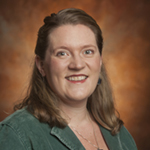Featuring Professor Lauren Myers, Psychology

I think community-based learning and research is a great way to ask students to practice something that a lot of faculty hope our students will be able to do. It allows students to speak about the material they are learning to a non-expert, or around the holiday dinner table, in a job interview, [or] to a colleague in the future. So, I think CBLR goals are general learning goals for many faculty.
-Professor Lauren Myers
Professor Lauren Myers is an Assistant Professor of Psychology at Lafayette College who continues to design significant learning experiences for her students. This newsletter highlights her implementation of community-based learning and research (CBLR) in her courses.
Her reasons for using CBLR are multi-faceted:
I started doing CBLR because I had seen from my colleagues here across the college that students’ most impactful learning experiences…occur when they are using information from the classroom to settings outside the classroom.
It also was an opportunity to do in a more formalized way something that I already had my students do more informally. To give Educational Psychology as an example, I have always, even when I had the informal CBLR, had students observe in K-12 classrooms across the Easton Area School District. What I liked about CBLR…is that we have a partner classroom and all of my students are going to observe in that same classroom with that same teacher. [I]t gave us more of an opportunity to have a back and forth and have a relationship, and kind of get to know each other a little bit. I have now done CBLR in Educational Psychology and Lifespan Development, and this semester I am doing it with both classes simultaneously.
The children in our partner classrooms, even though each individual student observed only 4 hours total, they got quite used to, ‘Oh, a Lafayette student is here today.’ It was just that general comfort with, ‘Oh, we have this partner classroom over at the College,’ and the children were really curious about the Lafayette students. If the teachers had a chance, they would use my students’ visits as a jumping off point for learning: for instance, to have the children find a student’s hometown on a map, or ask a student to say something in a language the children had never heard, or hear about what else a student was learning at the College.
Another motivation behind why Dr. Myers chose to implement CBLR is to allow students to participate in educational experiences beyond their own. In implementing the approach, she thinks it is important to make outside of class requirements known to the students at the beginning of the course:
It’s important to know [in] Week 1 what the expectations are for the students so that if they can’t commit to the outside of classroom requirements during the school day, they have an opportunity to take another course. It would be unfair if I said during Week 3, ‘Oh, you have to observe for the schools for 4 hours’ but they have a job that’s Monday through Friday 9 am to 5 pm and they now are committed to my class instead of another.
Her CBLR assignments are application-based. She asks students to create an observation summary where they describe what they saw and how it relates to concepts or theories from class. She provides formative feedback on that initial assignment, and the students refine their interpretations later in a final paper. The students in the partner classrooms also have the opportunity to visit the campus for a field trip for which Lafayette students prepare a mini-lesson or activity related to course content. Example topics from past activities generated by students include: how the brain changes when you learn, why friends need to stick together, how to work together toward a common goal, and the valuable things we learn from failure.
Professor Myers describes the value of having Lafayette students involved in CBLR outside of the classroom regardless of whether the content focuses on children and adolescents:
I think community-based learning and research is a great way to ask students to practice something that a lot of faculty hope our students will be able to do. It allows students to speak about the material they are learning to a non-expert, or around the holiday dinner table, in a job interview, [or] to a colleague in the future. So, I think CBLR goals are general learning goals for many faculty.
[I] am hoping this cohort of students in 10 years…[will] remember this project. They may not remember a whole lot of other detail about specific content from our class, but hopefully they will remember something about this. So, that is something that I am aiming for, to make a meaningful, memorable project that also impacts children’s schooling.
EVENT: The Power of Community-Based Learning & Research in and out of the Classroom
All faculty interested in learning more about CBLR, or who are currently using the approach, are invited to attend a keynote presentation and discussion led by Dr. Amy Koritz, Director, Center of Civic Engagement, Drew University on Wednesday, February 13th from 12 – 1:30 pm in the Wilson Room. Lunch will be provided. For more information about the event, see link below.
LEARN MORE
About Professor Myers’ CBLR Initiatives & Research
Educating Young Brains (Lafayette News)
Mad Libs, Balloons and Social Skills (Lafayette News)
About CBLR at Lafayette